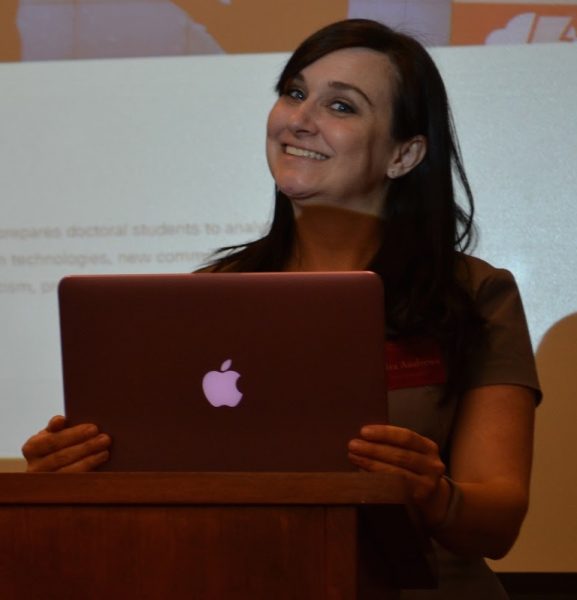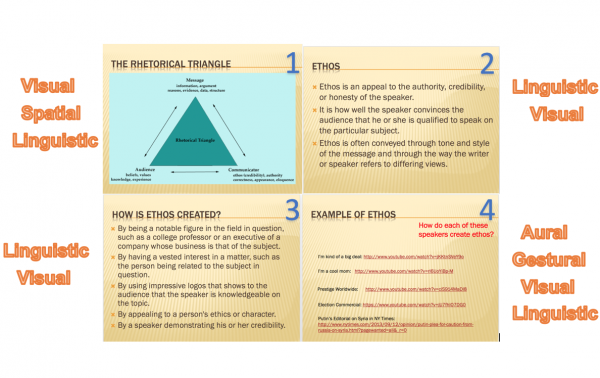Kendra Andrews is a third-year Communication, Rhetoric, & Digital Media student at NC State with a research focus on critical digital pedagogy. She is currently serving as the Graduate Assistant Director for the First-Year Writing Program and has been working in classrooms for nearly twenty years at the K-12 and university levels.
Teaching and Reflection
One of my biggest worries when I teach online is if what I put out there in the Internet ether is
really absorbed, understood, or even read by my virtual classroom. I have been trying to combat these web woes since I began working with online Learning Management Systems (LMS); however, using LMS in a F2F class was easier since I could explain my intentions to students as soon as I saw them face to face.
 But what if you never see your students or what if you only see them part of the time? What if your tried and true quips in the classroom don’t translate online? What if the only way that you can provide information, explanation, or important material is to put it online?
But what if you never see your students or what if you only see them part of the time? What if your tried and true quips in the classroom don’t translate online? What if the only way that you can provide information, explanation, or important material is to put it online?
I thought and thought about how to answer these questions and I stumbled on a maxim that has graced the walls of many of my classrooms: SHOW. DON’T TELL.
I’m not talking only about giving details and examples of what I’m writing about (even though that’s always a good rule of thumb), but I decided to use the multimodalities of the web to reinforce what I am hoping to get across to my students.
Multimodal Expression
In Writer/Designer (great book for students and instructors learning how to create multimodal projects), Kristin Arola, Cheryl Ball, and Jennifer Sheppard describe these modes:
- Visual: Style, color, images, perspective, size
- Aural: Music, sound, tone, emphasis and accent
- Spatial: Layout, structure, arrangement, and proximity
- Linguistic: word choice, delivery, writing style, development of ideas
- Gestural: interaction between people, facial expressions, gestures and body language
Even though I like to use multimodal projects (such as writer’s websites) throughout my course does not mean that everyone should follow that method. That’s not what I’m saying here.
What I am saying is that expressing myself to my students through multiple modes seems to reinforce what they are absorbing and learning from me. For example, let’s say that I am having them read a powerpoint on rhetoric (specifically ethos) before they discuss it in the forum. If I want them to really take in what something means and to entice them to move past skimming or even skipping the information altogether is to present the material in multiple modes, especially modes that they use daily. Below are the four slides that I use to describe “ethos” in my Introduction to Rhetoric powerpoint: I give the students the definition in a visual layout that contextualizes the term in the first slide, the second slide gives accessible definitions, the third slide provides examples of building ethos, and the final slides provide video and textual examples. For slide 4’s examples, I created the slide pre-Trump era, so there could be many other examples that you could provide more appropo for today’s climate.
I give the students the definition in a visual layout that contextualizes the term in the first slide, the second slide gives accessible definitions, the third slide provides examples of building ethos, and the final slides provide video and textual examples. For slide 4’s examples, I created the slide pre-Trump era, so there could be many other examples that you could provide more appropo for today’s climate.
Pop Culture and the Visual Mode
The audiovisual clips I chose are mostly from popular movies, youtube favorites, and then one coming from a journalistic source for perspective. The first clip is from Anchorman when Ron Burgundy explains how he’s “Kind of a Big Deal,” the second clip comes from Mean Girls as Amy Poehler tries to prove herself as “The Cool Mom,” the third clip is from Step Brothers as an “Ethos Fail?” and the final video is a political commercial where the ethos is prominent.
By using these clips or operating in the visual mode, I am almost guaranteed that the students are going to watch “ethos in action” even if they don’t read all of my slides that detail its definition. By recognizing the appeal in “everyday life,” the students become more connected to the content and the discussion board posts become much more interactive. In these posts, I usually have them operate primarily in a linguistic mode as they provide their own definition of ethos developed from the slides and find another video clip or textual application of ethos. The students are then asked to respond to each other (2 other students) by writing something specific that they liked in the post, and then extend an idea, ask a question, pose a problem or offer an example/connection.
Providing multiple ways of understanding, applying, and responding to new information has really helped me work through my issue of student understanding in virtual places. As I said earlier in the post, using multimodal means of understanding as well as producing works for me, but it may not work for everybody. I just know that since doing this, I have created a space where my students understand more of the information, interact more with each other, and apply their knowledge more easily in new situations online.
If you have any questions or some ideas for me, I’d love to chat! And if you would like any more ideas about video clips to use, I have a pretty extensive archive that I’m always willing to share with such a wonderful, knowledgeable faculty. You can leave comments below or email me at (klandre3@ncsu.edu).
Thanks for reading!

I love your slide examples. Thanks, Kendra!